Logistics and Supply Chain Management: Barilla Case Study Analysis
VerifiedAdded on 2020/03/04
|11
|2262
|73
Report
AI Summary
This report delves into the intricacies of logistics and supply chain management, using the Barilla case study as a central example. The report examines the Just-in-Time Delivery (JITD) program implemented by Barilla, analyzing its aims, potential conflicts, and the perspectives of various stakeholders, including customers. It explores the bullwhip effect, its causes, and potential solutions, such as information sharing, express delivery, collaborative forecasts, and vendor-managed inventory (VMI). The analysis covers the impact of e-commerce, everyday low pricing, and supply contracts on optimizing supply chain performance. The report provides recommendations for improving lead times and mitigating supply chain variability. The document also covers the competing objectives of farmers, manufacturers, distributors, and retailers. Ultimately, the report offers a comprehensive overview of supply chain challenges and strategies for achieving efficiency and effectiveness.
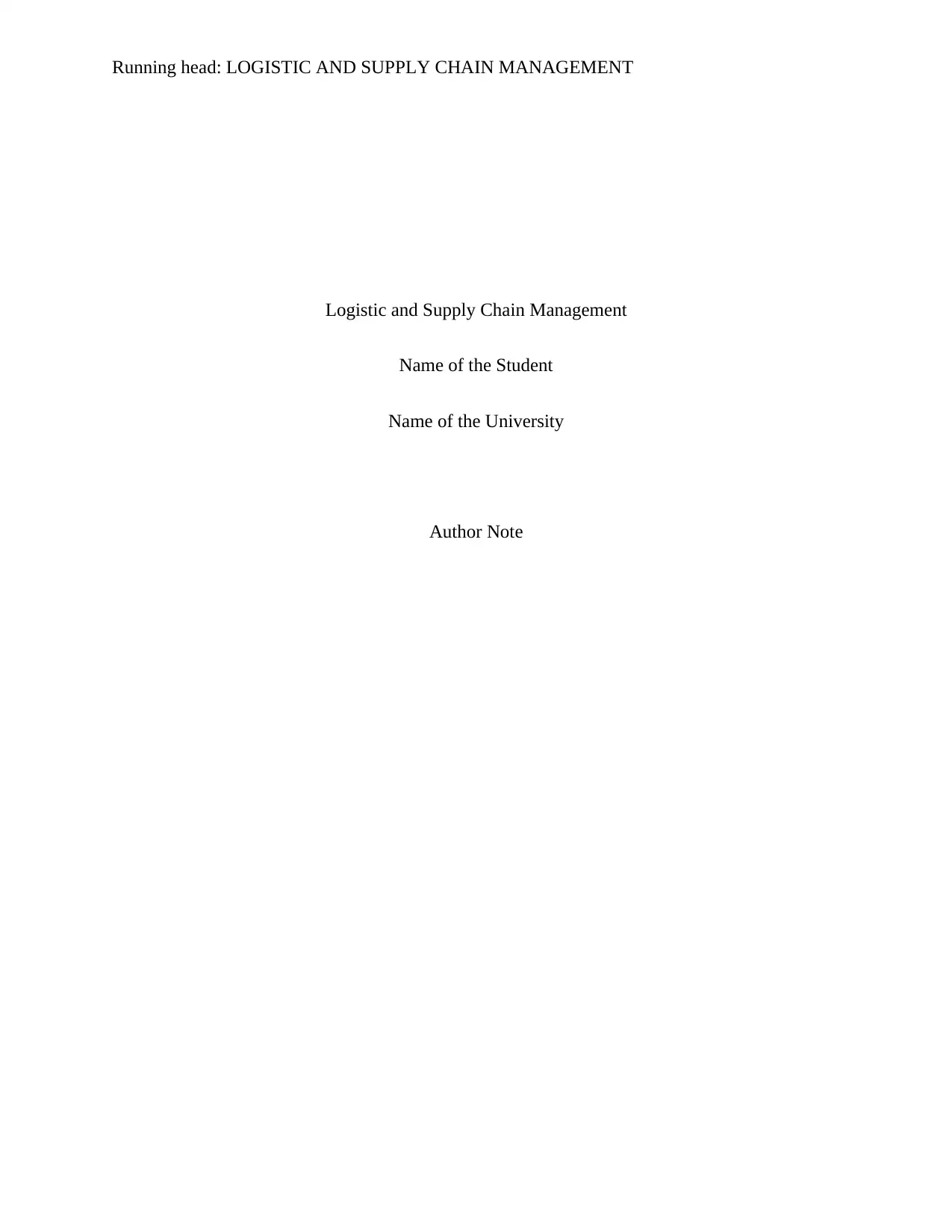
Running head: LOGISTIC AND SUPPLY CHAIN MANAGEMENT
Logistic and Supply Chain Management
Name of the Student
Name of the University
Author Note
Logistic and Supply Chain Management
Name of the Student
Name of the University
Author Note
Paraphrase This Document
Need a fresh take? Get an instant paraphrase of this document with our AI Paraphraser
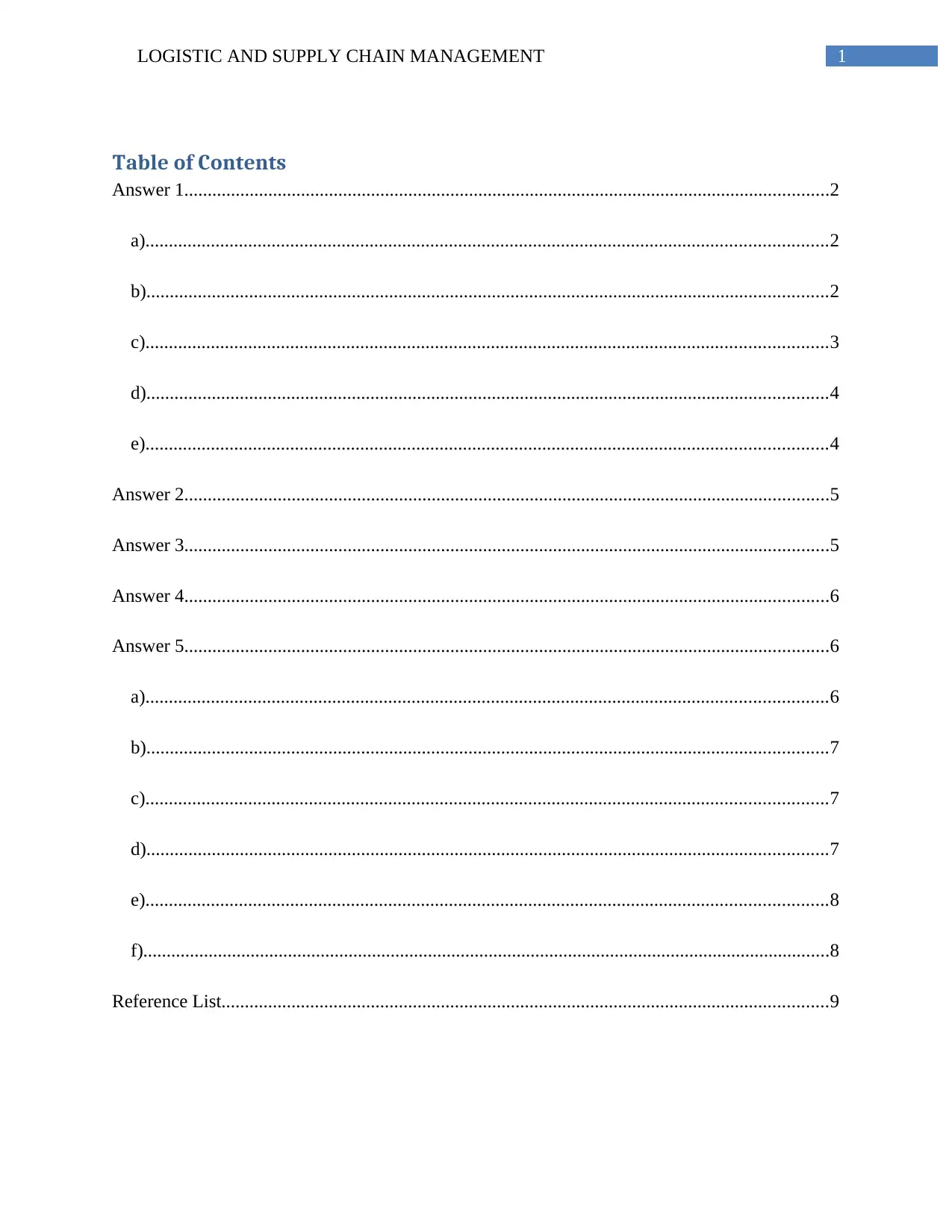
1LOGISTIC AND SUPPLY CHAIN MANAGEMENT
Table of Contents
Answer 1..........................................................................................................................................2
a)..................................................................................................................................................2
b)..................................................................................................................................................2
c)..................................................................................................................................................3
d)..................................................................................................................................................4
e)..................................................................................................................................................4
Answer 2..........................................................................................................................................5
Answer 3..........................................................................................................................................5
Answer 4..........................................................................................................................................6
Answer 5..........................................................................................................................................6
a)..................................................................................................................................................6
b)..................................................................................................................................................7
c)..................................................................................................................................................7
d)..................................................................................................................................................7
e)..................................................................................................................................................8
f)...................................................................................................................................................8
Reference List..................................................................................................................................9
Table of Contents
Answer 1..........................................................................................................................................2
a)..................................................................................................................................................2
b)..................................................................................................................................................2
c)..................................................................................................................................................3
d)..................................................................................................................................................4
e)..................................................................................................................................................4
Answer 2..........................................................................................................................................5
Answer 3..........................................................................................................................................5
Answer 4..........................................................................................................................................6
Answer 5..........................................................................................................................................6
a)..................................................................................................................................................6
b)..................................................................................................................................................7
c)..................................................................................................................................................7
d)..................................................................................................................................................7
e)..................................................................................................................................................8
f)...................................................................................................................................................8
Reference List..................................................................................................................................9
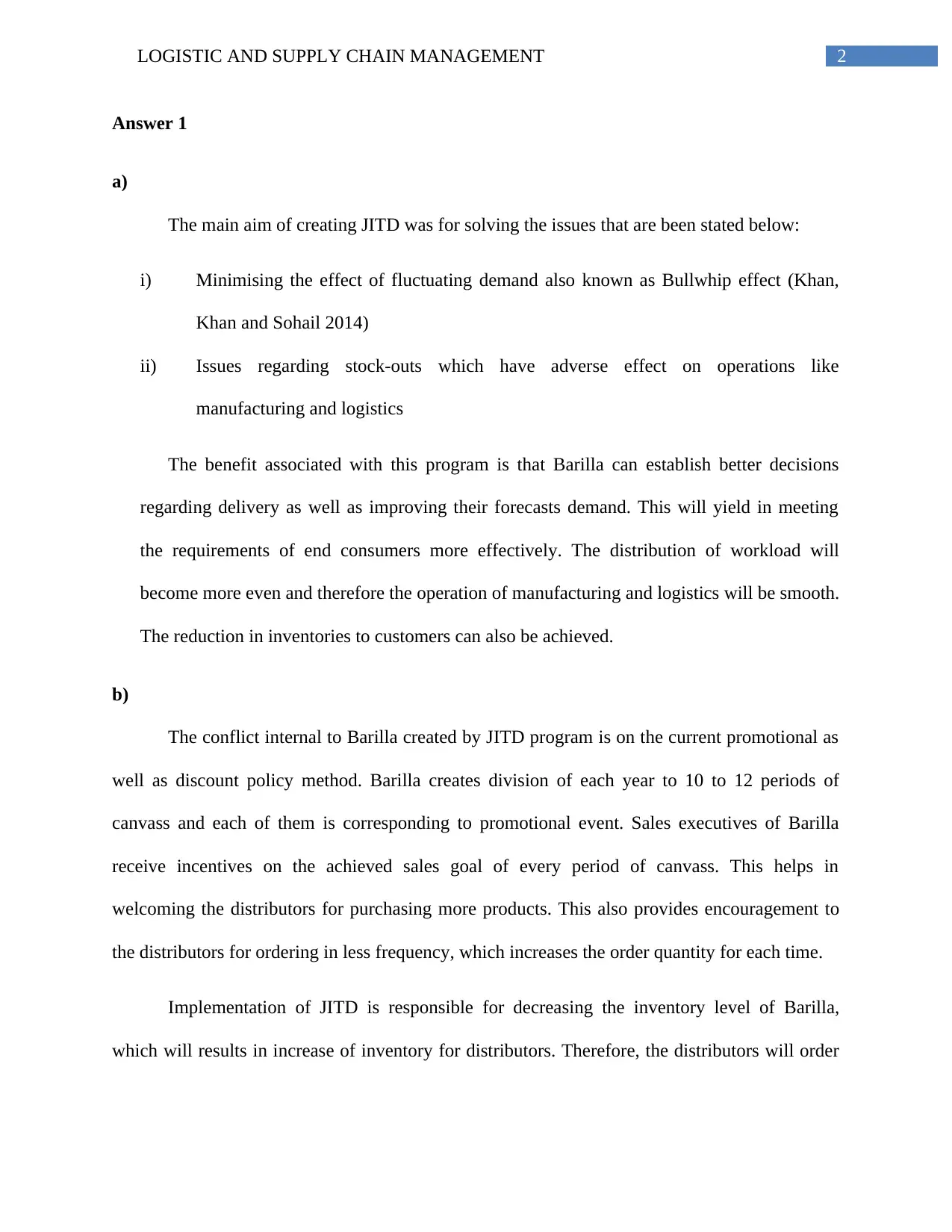
2LOGISTIC AND SUPPLY CHAIN MANAGEMENT
Answer 1
a)
The main aim of creating JITD was for solving the issues that are been stated below:
i) Minimising the effect of fluctuating demand also known as Bullwhip effect (Khan,
Khan and Sohail 2014)
ii) Issues regarding stock-outs which have adverse effect on operations like
manufacturing and logistics
The benefit associated with this program is that Barilla can establish better decisions
regarding delivery as well as improving their forecasts demand. This will yield in meeting
the requirements of end consumers more effectively. The distribution of workload will
become more even and therefore the operation of manufacturing and logistics will be smooth.
The reduction in inventories to customers can also be achieved.
b)
The conflict internal to Barilla created by JITD program is on the current promotional as
well as discount policy method. Barilla creates division of each year to 10 to 12 periods of
canvass and each of them is corresponding to promotional event. Sales executives of Barilla
receive incentives on the achieved sales goal of every period of canvass. This helps in
welcoming the distributors for purchasing more products. This also provides encouragement to
the distributors for ordering in less frequency, which increases the order quantity for each time.
Implementation of JITD is responsible for decreasing the inventory level of Barilla,
which will results in increase of inventory for distributors. Therefore, the distributors will order
Answer 1
a)
The main aim of creating JITD was for solving the issues that are been stated below:
i) Minimising the effect of fluctuating demand also known as Bullwhip effect (Khan,
Khan and Sohail 2014)
ii) Issues regarding stock-outs which have adverse effect on operations like
manufacturing and logistics
The benefit associated with this program is that Barilla can establish better decisions
regarding delivery as well as improving their forecasts demand. This will yield in meeting
the requirements of end consumers more effectively. The distribution of workload will
become more even and therefore the operation of manufacturing and logistics will be smooth.
The reduction in inventories to customers can also be achieved.
b)
The conflict internal to Barilla created by JITD program is on the current promotional as
well as discount policy method. Barilla creates division of each year to 10 to 12 periods of
canvass and each of them is corresponding to promotional event. Sales executives of Barilla
receive incentives on the achieved sales goal of every period of canvass. This helps in
welcoming the distributors for purchasing more products. This also provides encouragement to
the distributors for ordering in less frequency, which increases the order quantity for each time.
Implementation of JITD is responsible for decreasing the inventory level of Barilla,
which will results in increase of inventory for distributors. Therefore, the distributors will order
⊘ This is a preview!⊘
Do you want full access?
Subscribe today to unlock all pages.

Trusted by 1+ million students worldwide
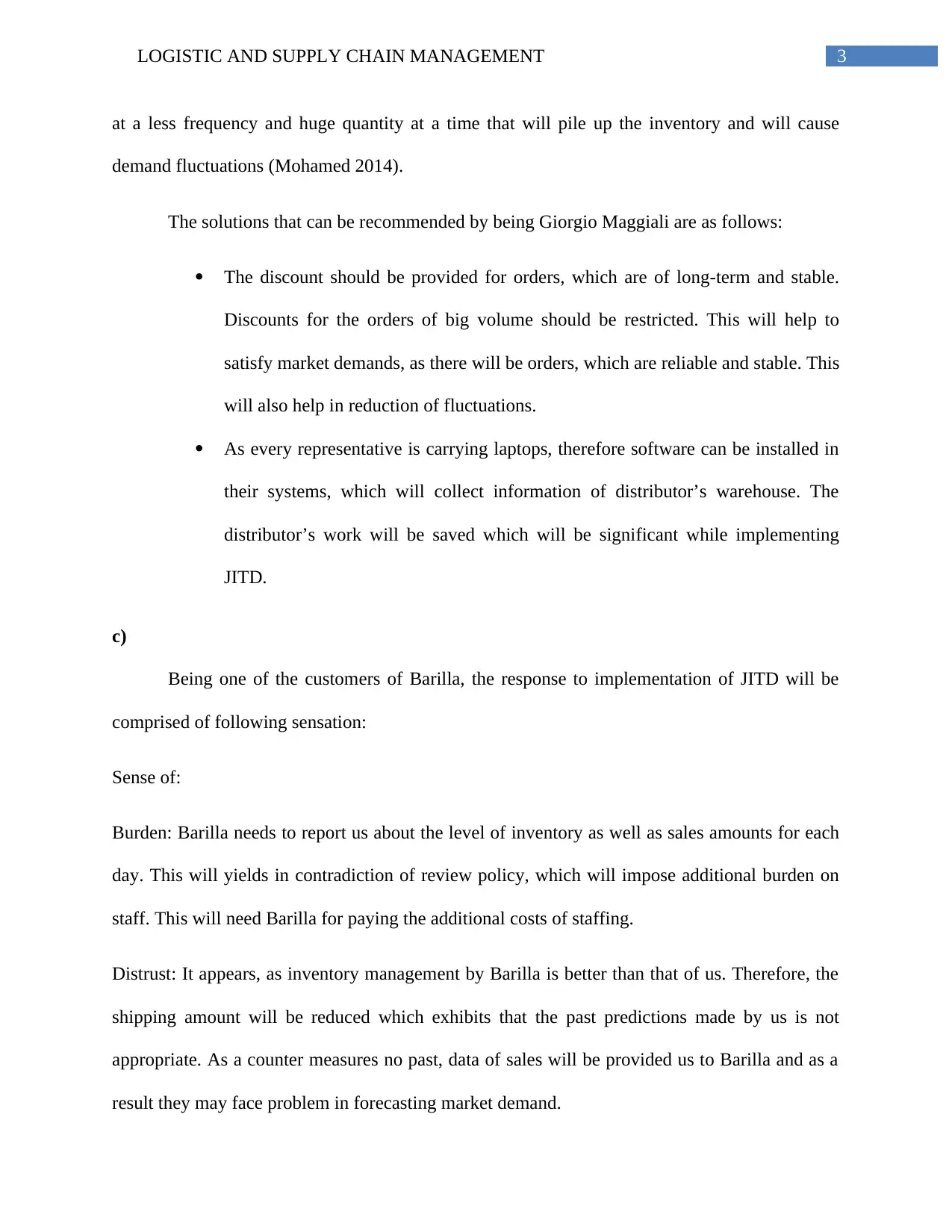
3LOGISTIC AND SUPPLY CHAIN MANAGEMENT
at a less frequency and huge quantity at a time that will pile up the inventory and will cause
demand fluctuations (Mohamed 2014).
The solutions that can be recommended by being Giorgio Maggiali are as follows:
The discount should be provided for orders, which are of long-term and stable.
Discounts for the orders of big volume should be restricted. This will help to
satisfy market demands, as there will be orders, which are reliable and stable. This
will also help in reduction of fluctuations.
As every representative is carrying laptops, therefore software can be installed in
their systems, which will collect information of distributor’s warehouse. The
distributor’s work will be saved which will be significant while implementing
JITD.
c)
Being one of the customers of Barilla, the response to implementation of JITD will be
comprised of following sensation:
Sense of:
Burden: Barilla needs to report us about the level of inventory as well as sales amounts for each
day. This will yields in contradiction of review policy, which will impose additional burden on
staff. This will need Barilla for paying the additional costs of staffing.
Distrust: It appears, as inventory management by Barilla is better than that of us. Therefore, the
shipping amount will be reduced which exhibits that the past predictions made by us is not
appropriate. As a counter measures no past, data of sales will be provided us to Barilla and as a
result they may face problem in forecasting market demand.
at a less frequency and huge quantity at a time that will pile up the inventory and will cause
demand fluctuations (Mohamed 2014).
The solutions that can be recommended by being Giorgio Maggiali are as follows:
The discount should be provided for orders, which are of long-term and stable.
Discounts for the orders of big volume should be restricted. This will help to
satisfy market demands, as there will be orders, which are reliable and stable. This
will also help in reduction of fluctuations.
As every representative is carrying laptops, therefore software can be installed in
their systems, which will collect information of distributor’s warehouse. The
distributor’s work will be saved which will be significant while implementing
JITD.
c)
Being one of the customers of Barilla, the response to implementation of JITD will be
comprised of following sensation:
Sense of:
Burden: Barilla needs to report us about the level of inventory as well as sales amounts for each
day. This will yields in contradiction of review policy, which will impose additional burden on
staff. This will need Barilla for paying the additional costs of staffing.
Distrust: It appears, as inventory management by Barilla is better than that of us. Therefore, the
shipping amount will be reduced which exhibits that the past predictions made by us is not
appropriate. As a counter measures no past, data of sales will be provided us to Barilla and as a
result they may face problem in forecasting market demand.
Paraphrase This Document
Need a fresh take? Get an instant paraphrase of this document with our AI Paraphraser
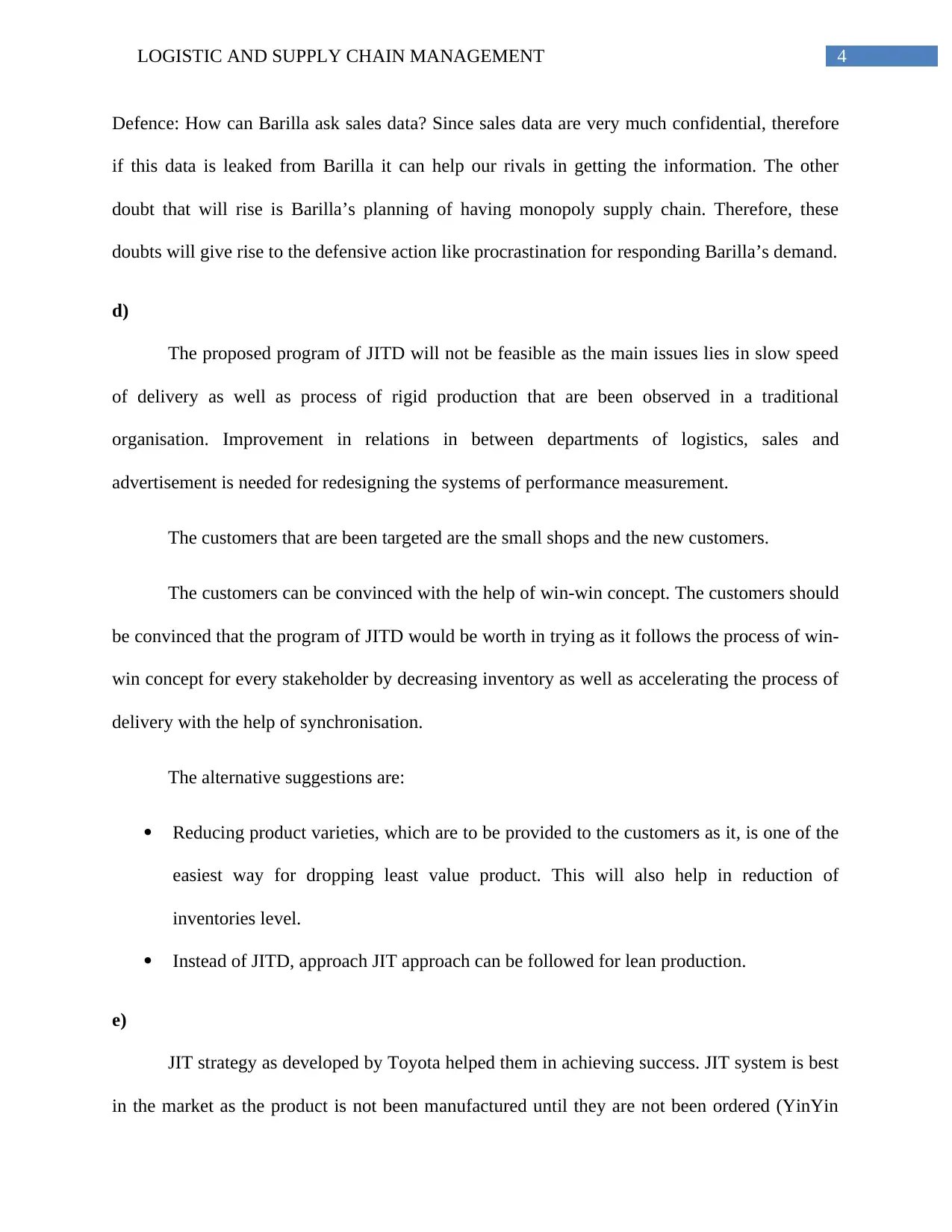
4LOGISTIC AND SUPPLY CHAIN MANAGEMENT
Defence: How can Barilla ask sales data? Since sales data are very much confidential, therefore
if this data is leaked from Barilla it can help our rivals in getting the information. The other
doubt that will rise is Barilla’s planning of having monopoly supply chain. Therefore, these
doubts will give rise to the defensive action like procrastination for responding Barilla’s demand.
d)
The proposed program of JITD will not be feasible as the main issues lies in slow speed
of delivery as well as process of rigid production that are been observed in a traditional
organisation. Improvement in relations in between departments of logistics, sales and
advertisement is needed for redesigning the systems of performance measurement.
The customers that are been targeted are the small shops and the new customers.
The customers can be convinced with the help of win-win concept. The customers should
be convinced that the program of JITD would be worth in trying as it follows the process of win-
win concept for every stakeholder by decreasing inventory as well as accelerating the process of
delivery with the help of synchronisation.
The alternative suggestions are:
Reducing product varieties, which are to be provided to the customers as it, is one of the
easiest way for dropping least value product. This will also help in reduction of
inventories level.
Instead of JITD, approach JIT approach can be followed for lean production.
e)
JIT strategy as developed by Toyota helped them in achieving success. JIT system is best
in the market as the product is not been manufactured until they are not been ordered (YinYin
Defence: How can Barilla ask sales data? Since sales data are very much confidential, therefore
if this data is leaked from Barilla it can help our rivals in getting the information. The other
doubt that will rise is Barilla’s planning of having monopoly supply chain. Therefore, these
doubts will give rise to the defensive action like procrastination for responding Barilla’s demand.
d)
The proposed program of JITD will not be feasible as the main issues lies in slow speed
of delivery as well as process of rigid production that are been observed in a traditional
organisation. Improvement in relations in between departments of logistics, sales and
advertisement is needed for redesigning the systems of performance measurement.
The customers that are been targeted are the small shops and the new customers.
The customers can be convinced with the help of win-win concept. The customers should
be convinced that the program of JITD would be worth in trying as it follows the process of win-
win concept for every stakeholder by decreasing inventory as well as accelerating the process of
delivery with the help of synchronisation.
The alternative suggestions are:
Reducing product varieties, which are to be provided to the customers as it, is one of the
easiest way for dropping least value product. This will also help in reduction of
inventories level.
Instead of JITD, approach JIT approach can be followed for lean production.
e)
JIT strategy as developed by Toyota helped them in achieving success. JIT system is best
in the market as the product is not been manufactured until they are not been ordered (YinYin
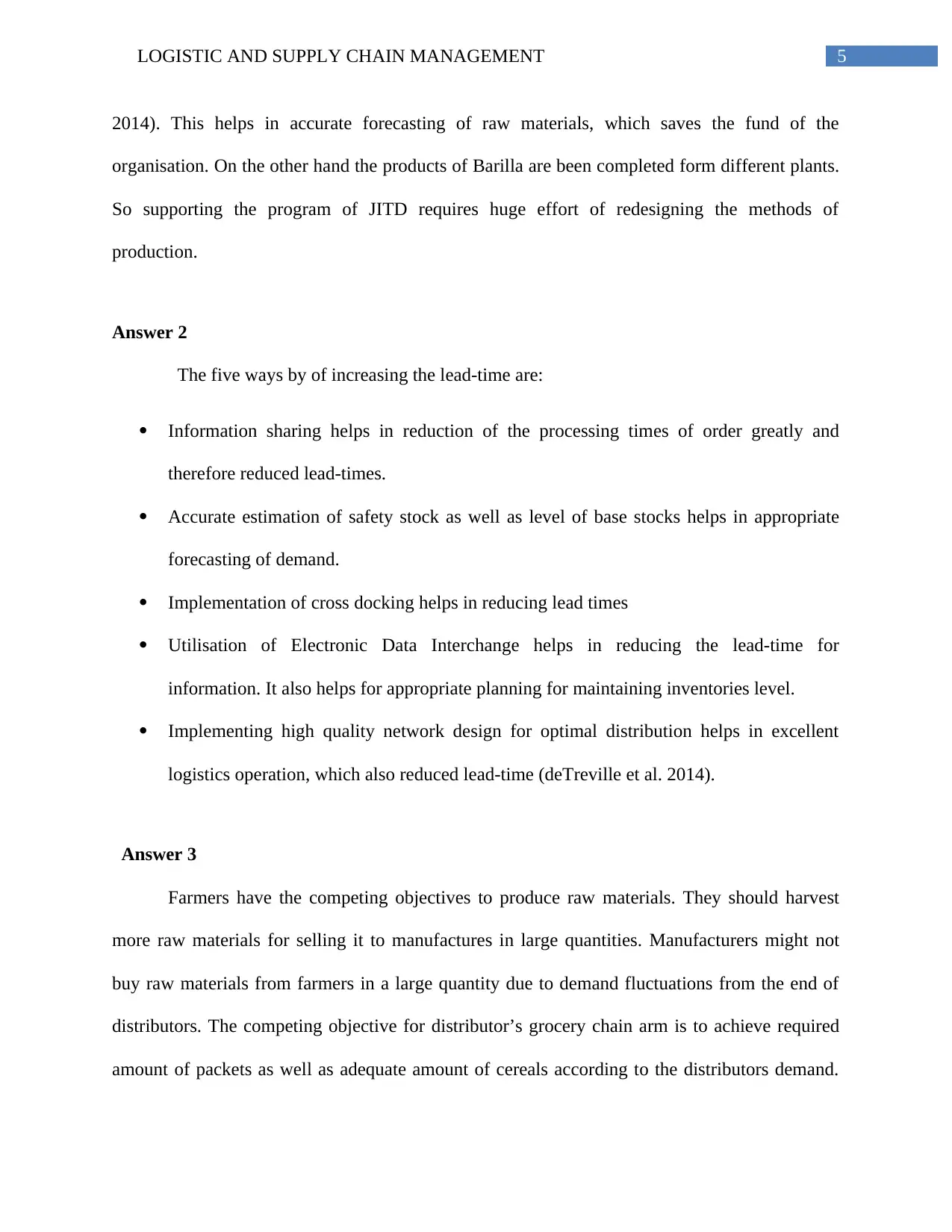
5LOGISTIC AND SUPPLY CHAIN MANAGEMENT
2014). This helps in accurate forecasting of raw materials, which saves the fund of the
organisation. On the other hand the products of Barilla are been completed form different plants.
So supporting the program of JITD requires huge effort of redesigning the methods of
production.
Answer 2
The five ways by of increasing the lead-time are:
Information sharing helps in reduction of the processing times of order greatly and
therefore reduced lead-times.
Accurate estimation of safety stock as well as level of base stocks helps in appropriate
forecasting of demand.
Implementation of cross docking helps in reducing lead times
Utilisation of Electronic Data Interchange helps in reducing the lead-time for
information. It also helps for appropriate planning for maintaining inventories level.
Implementing high quality network design for optimal distribution helps in excellent
logistics operation, which also reduced lead-time (deTreville et al. 2014).
Answer 3
Farmers have the competing objectives to produce raw materials. They should harvest
more raw materials for selling it to manufactures in large quantities. Manufacturers might not
buy raw materials from farmers in a large quantity due to demand fluctuations from the end of
distributors. The competing objective for distributor’s grocery chain arm is to achieve required
amount of packets as well as adequate amount of cereals according to the distributors demand.
2014). This helps in accurate forecasting of raw materials, which saves the fund of the
organisation. On the other hand the products of Barilla are been completed form different plants.
So supporting the program of JITD requires huge effort of redesigning the methods of
production.
Answer 2
The five ways by of increasing the lead-time are:
Information sharing helps in reduction of the processing times of order greatly and
therefore reduced lead-times.
Accurate estimation of safety stock as well as level of base stocks helps in appropriate
forecasting of demand.
Implementation of cross docking helps in reducing lead times
Utilisation of Electronic Data Interchange helps in reducing the lead-time for
information. It also helps for appropriate planning for maintaining inventories level.
Implementing high quality network design for optimal distribution helps in excellent
logistics operation, which also reduced lead-time (deTreville et al. 2014).
Answer 3
Farmers have the competing objectives to produce raw materials. They should harvest
more raw materials for selling it to manufactures in large quantities. Manufacturers might not
buy raw materials from farmers in a large quantity due to demand fluctuations from the end of
distributors. The competing objective for distributor’s grocery chain arm is to achieve required
amount of packets as well as adequate amount of cereals according to the distributors demand.
⊘ This is a preview!⊘
Do you want full access?
Subscribe today to unlock all pages.

Trusted by 1+ million students worldwide
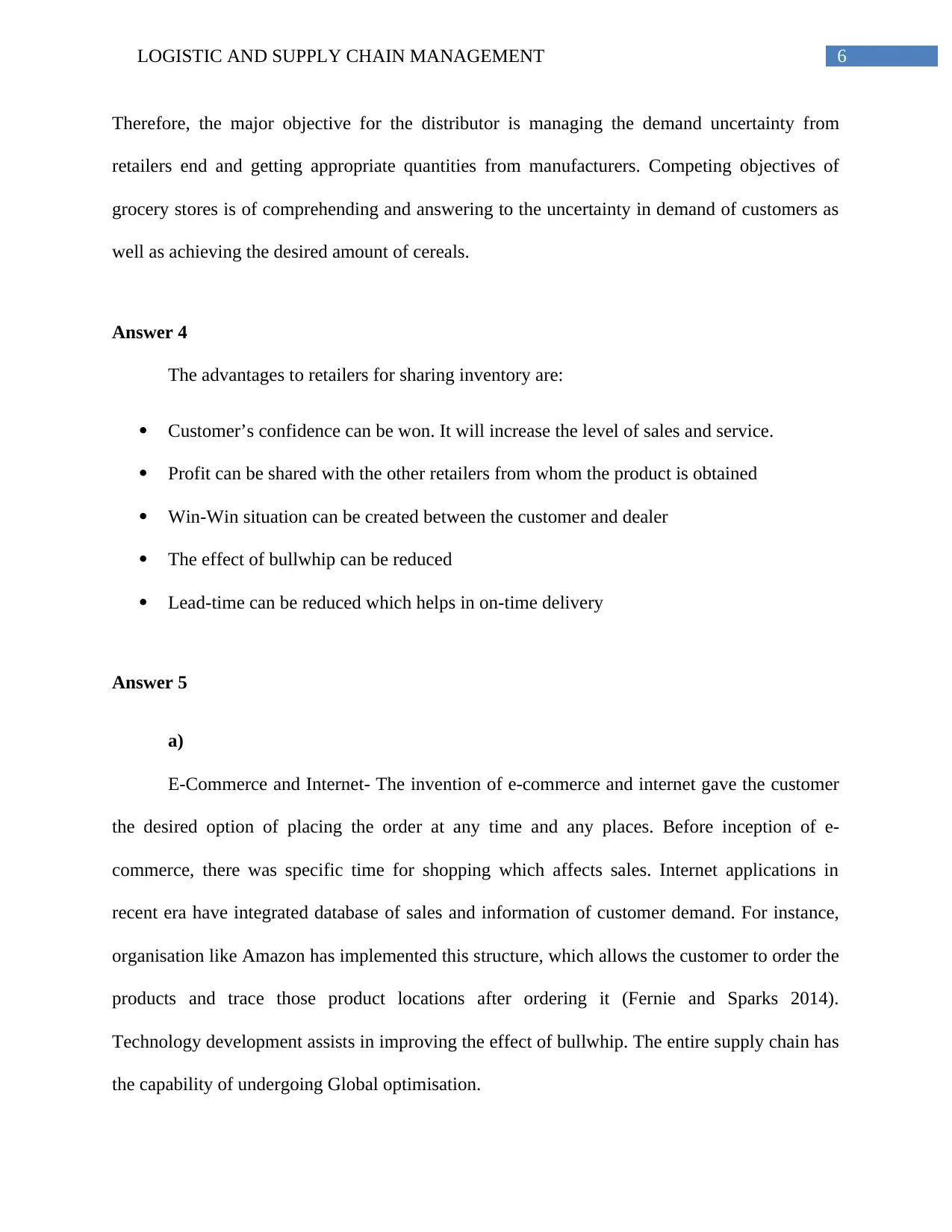
6LOGISTIC AND SUPPLY CHAIN MANAGEMENT
Therefore, the major objective for the distributor is managing the demand uncertainty from
retailers end and getting appropriate quantities from manufacturers. Competing objectives of
grocery stores is of comprehending and answering to the uncertainty in demand of customers as
well as achieving the desired amount of cereals.
Answer 4
The advantages to retailers for sharing inventory are:
Customer’s confidence can be won. It will increase the level of sales and service.
Profit can be shared with the other retailers from whom the product is obtained
Win-Win situation can be created between the customer and dealer
The effect of bullwhip can be reduced
Lead-time can be reduced which helps in on-time delivery
Answer 5
a)
E-Commerce and Internet- The invention of e-commerce and internet gave the customer
the desired option of placing the order at any time and any places. Before inception of e-
commerce, there was specific time for shopping which affects sales. Internet applications in
recent era have integrated database of sales and information of customer demand. For instance,
organisation like Amazon has implemented this structure, which allows the customer to order the
products and trace those product locations after ordering it (Fernie and Sparks 2014).
Technology development assists in improving the effect of bullwhip. The entire supply chain has
the capability of undergoing Global optimisation.
Therefore, the major objective for the distributor is managing the demand uncertainty from
retailers end and getting appropriate quantities from manufacturers. Competing objectives of
grocery stores is of comprehending and answering to the uncertainty in demand of customers as
well as achieving the desired amount of cereals.
Answer 4
The advantages to retailers for sharing inventory are:
Customer’s confidence can be won. It will increase the level of sales and service.
Profit can be shared with the other retailers from whom the product is obtained
Win-Win situation can be created between the customer and dealer
The effect of bullwhip can be reduced
Lead-time can be reduced which helps in on-time delivery
Answer 5
a)
E-Commerce and Internet- The invention of e-commerce and internet gave the customer
the desired option of placing the order at any time and any places. Before inception of e-
commerce, there was specific time for shopping which affects sales. Internet applications in
recent era have integrated database of sales and information of customer demand. For instance,
organisation like Amazon has implemented this structure, which allows the customer to order the
products and trace those product locations after ordering it (Fernie and Sparks 2014).
Technology development assists in improving the effect of bullwhip. The entire supply chain has
the capability of undergoing Global optimisation.
Paraphrase This Document
Need a fresh take? Get an instant paraphrase of this document with our AI Paraphraser
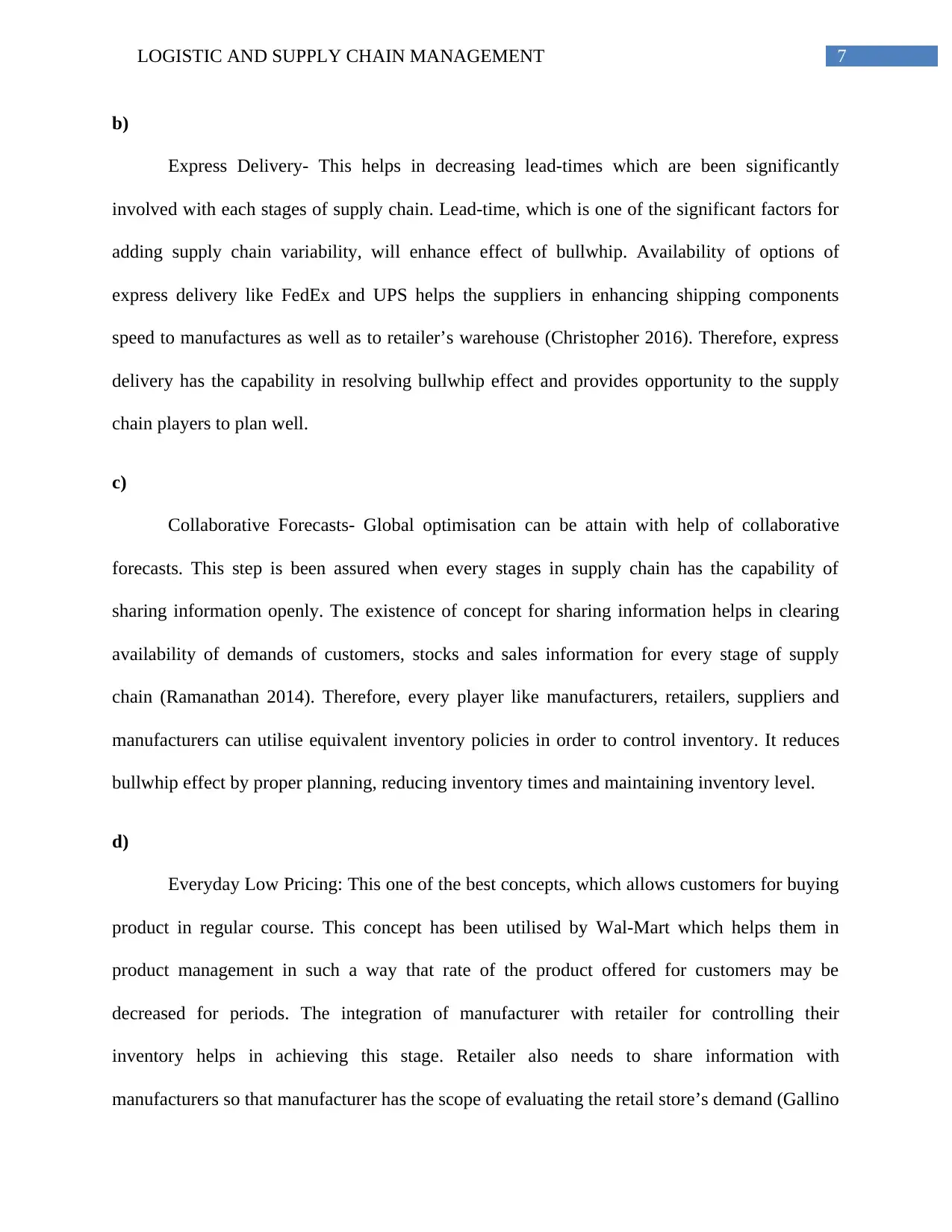
7LOGISTIC AND SUPPLY CHAIN MANAGEMENT
b)
Express Delivery- This helps in decreasing lead-times which are been significantly
involved with each stages of supply chain. Lead-time, which is one of the significant factors for
adding supply chain variability, will enhance effect of bullwhip. Availability of options of
express delivery like FedEx and UPS helps the suppliers in enhancing shipping components
speed to manufactures as well as to retailer’s warehouse (Christopher 2016). Therefore, express
delivery has the capability in resolving bullwhip effect and provides opportunity to the supply
chain players to plan well.
c)
Collaborative Forecasts- Global optimisation can be attain with help of collaborative
forecasts. This step is been assured when every stages in supply chain has the capability of
sharing information openly. The existence of concept for sharing information helps in clearing
availability of demands of customers, stocks and sales information for every stage of supply
chain (Ramanathan 2014). Therefore, every player like manufacturers, retailers, suppliers and
manufacturers can utilise equivalent inventory policies in order to control inventory. It reduces
bullwhip effect by proper planning, reducing inventory times and maintaining inventory level.
d)
Everyday Low Pricing: This one of the best concepts, which allows customers for buying
product in regular course. This concept has been utilised by Wal-Mart which helps them in
product management in such a way that rate of the product offered for customers may be
decreased for periods. The integration of manufacturer with retailer for controlling their
inventory helps in achieving this stage. Retailer also needs to share information with
manufacturers so that manufacturer has the scope of evaluating the retail store’s demand (Gallino
b)
Express Delivery- This helps in decreasing lead-times which are been significantly
involved with each stages of supply chain. Lead-time, which is one of the significant factors for
adding supply chain variability, will enhance effect of bullwhip. Availability of options of
express delivery like FedEx and UPS helps the suppliers in enhancing shipping components
speed to manufactures as well as to retailer’s warehouse (Christopher 2016). Therefore, express
delivery has the capability in resolving bullwhip effect and provides opportunity to the supply
chain players to plan well.
c)
Collaborative Forecasts- Global optimisation can be attain with help of collaborative
forecasts. This step is been assured when every stages in supply chain has the capability of
sharing information openly. The existence of concept for sharing information helps in clearing
availability of demands of customers, stocks and sales information for every stage of supply
chain (Ramanathan 2014). Therefore, every player like manufacturers, retailers, suppliers and
manufacturers can utilise equivalent inventory policies in order to control inventory. It reduces
bullwhip effect by proper planning, reducing inventory times and maintaining inventory level.
d)
Everyday Low Pricing: This one of the best concepts, which allows customers for buying
product in regular course. This concept has been utilised by Wal-Mart which helps them in
product management in such a way that rate of the product offered for customers may be
decreased for periods. The integration of manufacturer with retailer for controlling their
inventory helps in achieving this stage. Retailer also needs to share information with
manufacturers so that manufacturer has the scope of evaluating the retail store’s demand (Gallino
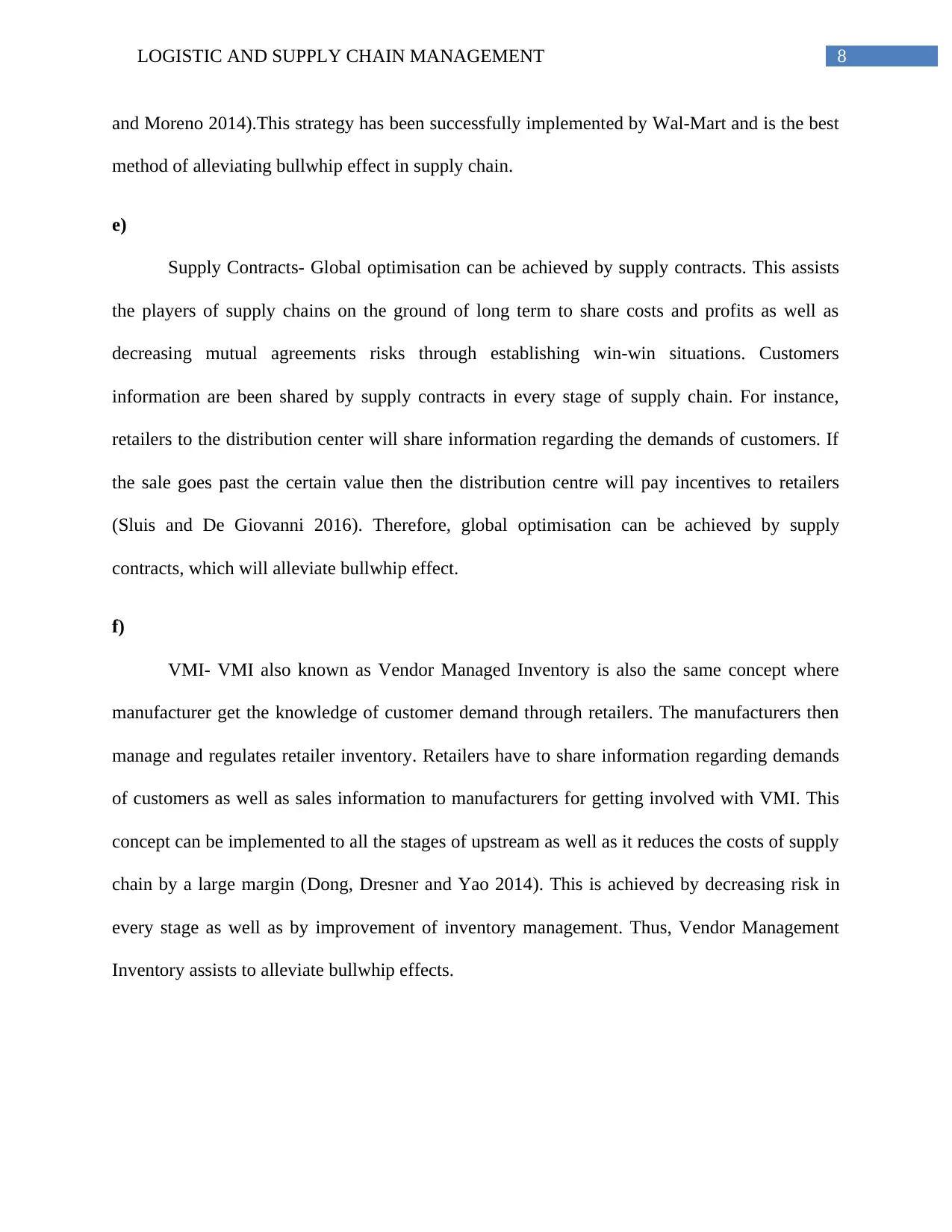
8LOGISTIC AND SUPPLY CHAIN MANAGEMENT
and Moreno 2014).This strategy has been successfully implemented by Wal-Mart and is the best
method of alleviating bullwhip effect in supply chain.
e)
Supply Contracts- Global optimisation can be achieved by supply contracts. This assists
the players of supply chains on the ground of long term to share costs and profits as well as
decreasing mutual agreements risks through establishing win-win situations. Customers
information are been shared by supply contracts in every stage of supply chain. For instance,
retailers to the distribution center will share information regarding the demands of customers. If
the sale goes past the certain value then the distribution centre will pay incentives to retailers
(Sluis and De Giovanni 2016). Therefore, global optimisation can be achieved by supply
contracts, which will alleviate bullwhip effect.
f)
VMI- VMI also known as Vendor Managed Inventory is also the same concept where
manufacturer get the knowledge of customer demand through retailers. The manufacturers then
manage and regulates retailer inventory. Retailers have to share information regarding demands
of customers as well as sales information to manufacturers for getting involved with VMI. This
concept can be implemented to all the stages of upstream as well as it reduces the costs of supply
chain by a large margin (Dong, Dresner and Yao 2014). This is achieved by decreasing risk in
every stage as well as by improvement of inventory management. Thus, Vendor Management
Inventory assists to alleviate bullwhip effects.
and Moreno 2014).This strategy has been successfully implemented by Wal-Mart and is the best
method of alleviating bullwhip effect in supply chain.
e)
Supply Contracts- Global optimisation can be achieved by supply contracts. This assists
the players of supply chains on the ground of long term to share costs and profits as well as
decreasing mutual agreements risks through establishing win-win situations. Customers
information are been shared by supply contracts in every stage of supply chain. For instance,
retailers to the distribution center will share information regarding the demands of customers. If
the sale goes past the certain value then the distribution centre will pay incentives to retailers
(Sluis and De Giovanni 2016). Therefore, global optimisation can be achieved by supply
contracts, which will alleviate bullwhip effect.
f)
VMI- VMI also known as Vendor Managed Inventory is also the same concept where
manufacturer get the knowledge of customer demand through retailers. The manufacturers then
manage and regulates retailer inventory. Retailers have to share information regarding demands
of customers as well as sales information to manufacturers for getting involved with VMI. This
concept can be implemented to all the stages of upstream as well as it reduces the costs of supply
chain by a large margin (Dong, Dresner and Yao 2014). This is achieved by decreasing risk in
every stage as well as by improvement of inventory management. Thus, Vendor Management
Inventory assists to alleviate bullwhip effects.
⊘ This is a preview!⊘
Do you want full access?
Subscribe today to unlock all pages.

Trusted by 1+ million students worldwide
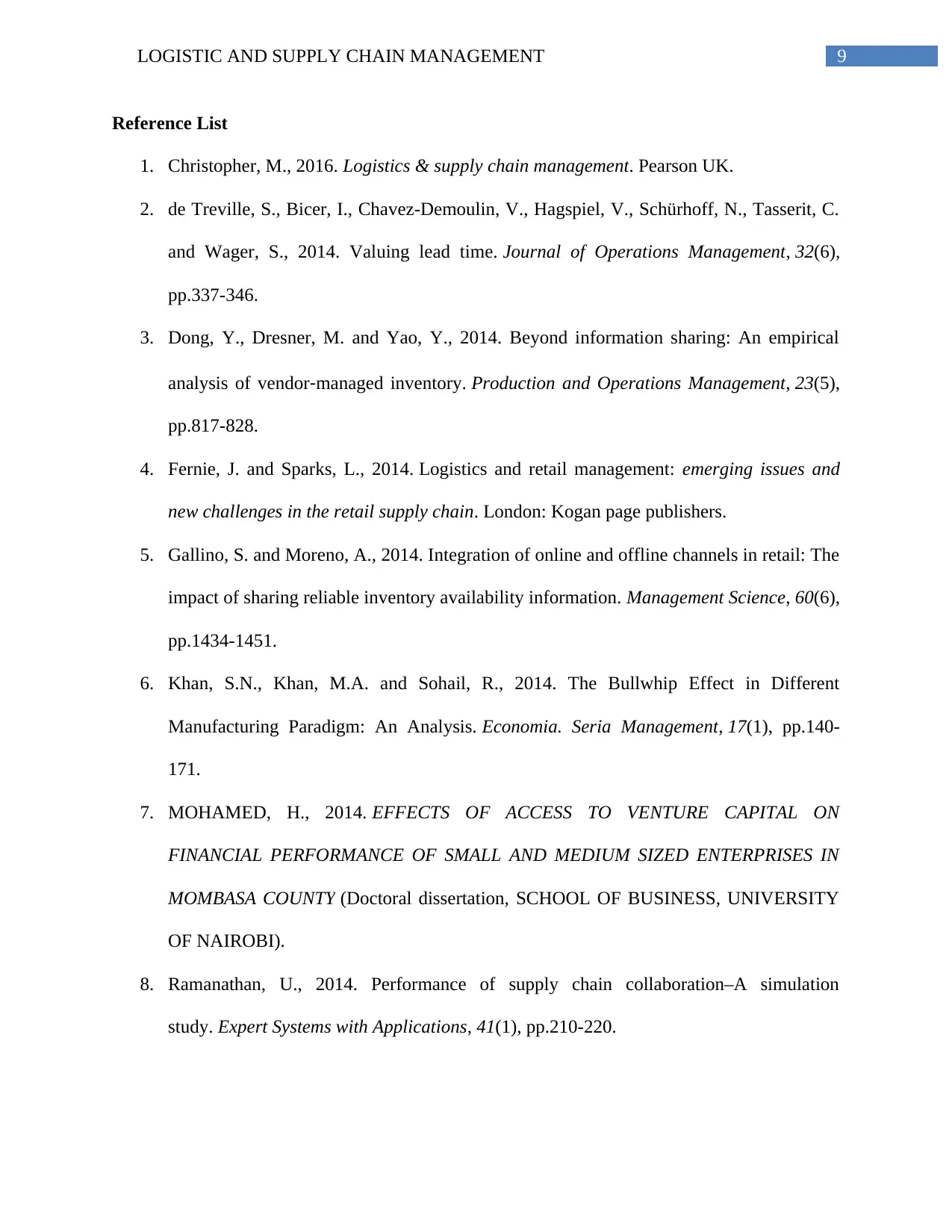
9LOGISTIC AND SUPPLY CHAIN MANAGEMENT
Reference List
1. Christopher, M., 2016. Logistics & supply chain management. Pearson UK.
2. de Treville, S., Bicer, I., Chavez-Demoulin, V., Hagspiel, V., Schürhoff, N., Tasserit, C.
and Wager, S., 2014. Valuing lead time. Journal of Operations Management, 32(6),
pp.337-346.
3. Dong, Y., Dresner, M. and Yao, Y., 2014. Beyond information sharing: An empirical
analysis of vendor‐managed inventory. Production and Operations Management, 23(5),
pp.817-828.
4. Fernie, J. and Sparks, L., 2014. Logistics and retail management: emerging issues and
new challenges in the retail supply chain. London: Kogan page publishers.
5. Gallino, S. and Moreno, A., 2014. Integration of online and offline channels in retail: The
impact of sharing reliable inventory availability information. Management Science, 60(6),
pp.1434-1451.
6. Khan, S.N., Khan, M.A. and Sohail, R., 2014. The Bullwhip Effect in Different
Manufacturing Paradigm: An Analysis. Economia. Seria Management, 17(1), pp.140-
171.
7. MOHAMED, H., 2014. EFFECTS OF ACCESS TO VENTURE CAPITAL ON
FINANCIAL PERFORMANCE OF SMALL AND MEDIUM SIZED ENTERPRISES IN
MOMBASA COUNTY (Doctoral dissertation, SCHOOL OF BUSINESS, UNIVERSITY
OF NAIROBI).
8. Ramanathan, U., 2014. Performance of supply chain collaboration–A simulation
study. Expert Systems with Applications, 41(1), pp.210-220.
Reference List
1. Christopher, M., 2016. Logistics & supply chain management. Pearson UK.
2. de Treville, S., Bicer, I., Chavez-Demoulin, V., Hagspiel, V., Schürhoff, N., Tasserit, C.
and Wager, S., 2014. Valuing lead time. Journal of Operations Management, 32(6),
pp.337-346.
3. Dong, Y., Dresner, M. and Yao, Y., 2014. Beyond information sharing: An empirical
analysis of vendor‐managed inventory. Production and Operations Management, 23(5),
pp.817-828.
4. Fernie, J. and Sparks, L., 2014. Logistics and retail management: emerging issues and
new challenges in the retail supply chain. London: Kogan page publishers.
5. Gallino, S. and Moreno, A., 2014. Integration of online and offline channels in retail: The
impact of sharing reliable inventory availability information. Management Science, 60(6),
pp.1434-1451.
6. Khan, S.N., Khan, M.A. and Sohail, R., 2014. The Bullwhip Effect in Different
Manufacturing Paradigm: An Analysis. Economia. Seria Management, 17(1), pp.140-
171.
7. MOHAMED, H., 2014. EFFECTS OF ACCESS TO VENTURE CAPITAL ON
FINANCIAL PERFORMANCE OF SMALL AND MEDIUM SIZED ENTERPRISES IN
MOMBASA COUNTY (Doctoral dissertation, SCHOOL OF BUSINESS, UNIVERSITY
OF NAIROBI).
8. Ramanathan, U., 2014. Performance of supply chain collaboration–A simulation
study. Expert Systems with Applications, 41(1), pp.210-220.
Paraphrase This Document
Need a fresh take? Get an instant paraphrase of this document with our AI Paraphraser

10LOGISTIC AND SUPPLY CHAIN MANAGEMENT
9. Sluis, S. and De Giovanni, P., 2016. The selection of contracts in supply chains: An
empirical analysis. Journal of Operations Management, 41, pp.1-11.
10. Yinyin, W., 2014. Study on JIT Supply, Demand and Purchasing Model of Ship-building
Industry. Logistics Technology, 17, p.070.
9. Sluis, S. and De Giovanni, P., 2016. The selection of contracts in supply chains: An
empirical analysis. Journal of Operations Management, 41, pp.1-11.
10. Yinyin, W., 2014. Study on JIT Supply, Demand and Purchasing Model of Ship-building
Industry. Logistics Technology, 17, p.070.
1 out of 11
Related Documents
Your All-in-One AI-Powered Toolkit for Academic Success.
+13062052269
info@desklib.com
Available 24*7 on WhatsApp / Email
![[object Object]](/_next/static/media/star-bottom.7253800d.svg)
Unlock your academic potential
Copyright © 2020–2025 A2Z Services. All Rights Reserved. Developed and managed by ZUCOL.





